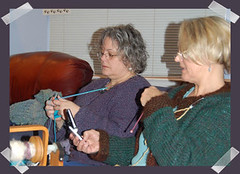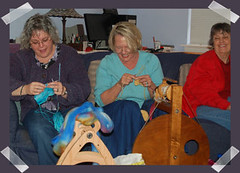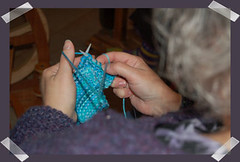 If you get one of the new High Efficiency front loading washing machines, you will notice that your clothes are suddenly a whole lot cleaner and seem much dryer when they come out of the wash than they did when all you had was your top loader. The new machines use a lot less water than the top loaders and they are much more gentle on your clothes. They have a computer in control that evaluates the load and decides how much water to use and how much washing is really needed.
If you get one of the new High Efficiency front loading washing machines, you will notice that your clothes are suddenly a whole lot cleaner and seem much dryer when they come out of the wash than they did when all you had was your top loader. The new machines use a lot less water than the top loaders and they are much more gentle on your clothes. They have a computer in control that evaluates the load and decides how much water to use and how much washing is really needed.When you tell your knitting friends who do not have a front loader yet, about your new acquisition, I bet the first thing you hear is that it is nice for you to have a modern machine, but to forget felting your knitting ever again - unless it is something that you don't want felted!
Well, friends, do not despair. You can felt in your front loader, but you will have to be more determined than before. Felting in the front loader is even more of an art than it used to be in the top loader, because the first thing you have to do is outsmart your smart washing machine! Things probably won't felt in 5 minutes like before - it may take one or two complete cycles to get the look you want.
I would tell you to start by reading the book that comes with the machine so that you understand all the settings, but my experience is that the books are totally worthless and do not cover how to take control of your washer. For example, my washer - an LG brand - will spin out without spraying water if I just turn it on, and select the spin speed I want then press the start button. This is not documented anywhere in the book that came with it. Someone on the Internet made this discovery and shared it on one of the lists I read in response to my whining.
Felting wool requires heat and agitation - and your agitation does not count. Since the washer computes how much water to use, if you just put your item to be felted in, with nothing else, don't expect much felting to occur - unless the wool felts super easy. So, find out how to run your load with really hot water. One item is not going to create much agitation either.
Get yourself some felting helpers to build a load that will definitely cause some agitation as well as adding weight to the load to fool the computer into thinking that you have a big load - and thus need more water.
I have some items that I keep just for my felting loads. My recipe consists of one dozen tennis balls. The photo shows them in a mesh bag, but I dump them loose in the machine when I felt. Add to the balls, one pair of old jeans (or more) a pair of flip flops, one old towel (or more) and an optional pair of old tennis shoes. Now you have an agitating load!
The next thing you have to do is experiment a little - remember this is an art and all front loaders are not created equally plus different wools felt at different rates. The best thing to do is to make a swatch (this is not a dirty word!) and felt it using the concoction you have assembled to do the deed.
Wet your swatch and don't squeeze out too much water. I have found that a wet swatch felts faster than a dry one. I guess it is because no wash water is wasted getting it wet, and you get a fast temperature change - one of the felting keys.
Put your swatch in a zippered pillow cover then into the wash. Don't forget to add a little soap , Dawn or Synthropol (not detergent since it contains whiteners). Set your machine on hot or Sani-Wash and let her rip! The swatch needs to be at least 6 inches wide and long so you are getting something to work with.
In my front loader, I can usually get a satisfactory felted item in one wash cycle for most wools, but for others it takes two cycles. I have found I have to use the Sani-Wash cycle to get really hot water most of the time. I also pick a long cycle, although some people say that it is the temperature changes that cause the felting to occur, so a shorter cycle might work too.
Felting time does vary with the wool used. I had one commercial yarn that felted well in my machine with half of a normal hot wash cycle. A long hot cycle would have ruined this project. My favorite handspun wool takes two to three Sani-Wash (extra hot and long) cycles to make suitable felt. So, experience is the best teacher, and when in doubt, swatch and felt the swatch.
Once your item is felted to your liking, pull and stretch it into shape over a box and or towels or other stuffing that makes it the right size. Then let it dry.
If you want to read a good felting reference, I suggest either of Kathleen Taylor's books on felting - Knit One Felt Too or I Heart Felting. She has some great information about swatches and felting in both of those books. She does not have front loader specific stuff though.
Good luck with your felting projects!















 After lunch we had our "workshops." Marlene bought her
After lunch we had our "workshops." Marlene bought her  Laurie and Joanne tried it out while the rest of us kept spinning. There were some fits and starts. Joanne thought she was doing the knit stitch, but it turned our she had learned the purl stitch. There was lots of laughing about this.
Laurie and Joanne tried it out while the rest of us kept spinning. There were some fits and starts. Joanne thought she was doing the knit stitch, but it turned our she had learned the purl stitch. There was lots of laughing about this.  After everyone left, I searched YouTube for
After everyone left, I searched YouTube for 
